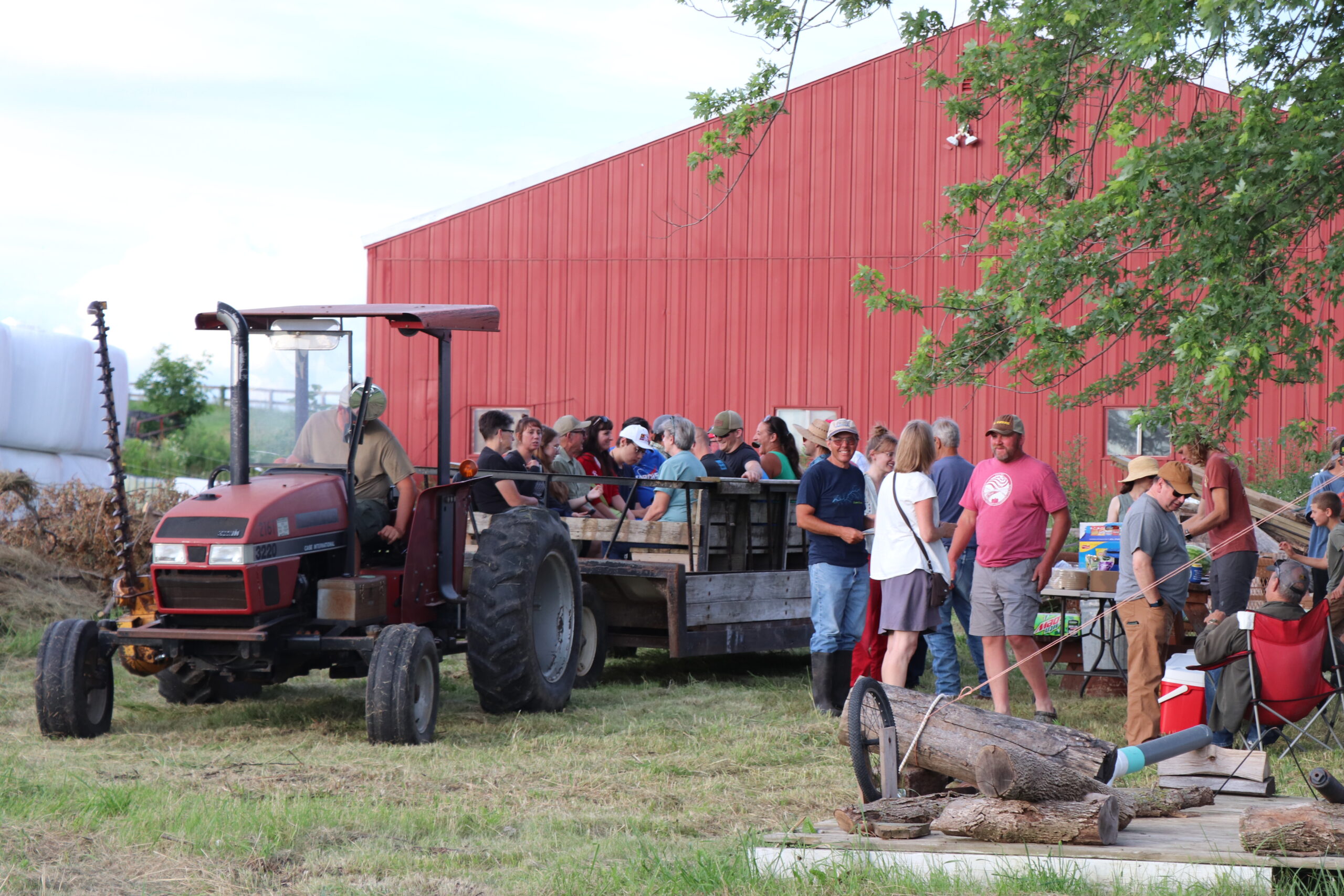Photo Credit: Coon Creek watershed residents gathered at Highland Farm in the headwaters of the watershed on July 3rd for the Coon Creek Community Watershed’s July meeting.
Managed Grazing and Strawberry Cake on the Agenda for July Watershed Council Meeting
COON VALLEY, Wis.- More than 40 people gathered in the headwaters of the Coon Creek Watershed to learn about managed grazing and organic dairy farming during the Coon Creek Community Watershed Council’s (CCCWC) July 3 meeting.
The Canter family, who hosted the meeting, hoped that attendees left their farm with more confidence to experiment with conservation practices, and were inspired to think about ways they could “make running water walk” in their own places across the watershed.
“Every little bit helps,” Matthew Canter said. “Sometimes what I do can feel innocuous when I’m surrounded by an ocean of non-conservation, but for every little bit I do, things downstream could be a little bit better.”
Canter, who also serves on CCCWC’s board, grazes 100 cows with his family on a 300 acre organic dairy farm on Rognstad Ridge. His wife, Ashley, says that their farming practices have not only helped improve soil health and store water on their ridgetop farm, but that they’re something that brings her family together.
“I love how the farm binds us together,” Ashley said. “Especially as a homeschooling family, we all work here but we all live here too. Everyone has chores; at every age the children have something to contribute, but we don’t simply finish the work and move on with other activities. The farm is all around us, all the time: in the eggs and milk we enjoy for breakfast, the wildlife we study for science, and the spaces we run in for imagination and play. The farm is at the heart of what we believe and teach our children about the gift of living.”
Coon Creek watershed residents joined the Canter family during the July meeting for fresh strawberry cake, a tractor ride, and a golden hour walk through the Canters’ ridgetop pastures.
Canter explained that rotationally grazing his herd of Jerseys, Ayrshires, and Normande Crosses helps his cows and pastures thrive. The cows stay active and enjoy a diet full of fresh, nutrient-packed grasses. In turn, they produce high quality, nutrient-packed milk. At the same time, the cows help fertilize the pastures by trampling organic matter into the soil, and their grazing pressure can stimulate grass growth.
“Overwhelmingly, our practices are governed by the way we manage our animals,” Canter said. “The impact on the land of moving the animals very quickly in large groups to different fields is still surprising to me”
The Canters moved to their farm on Rognstad Ridge from Ohio in 2007. In 2015, they took up organic sheep rearing, and expanded their practice to include dairy farming two years later.
“Getting past that 5-7 year hurdle, things start to look, if not lucrative, at the very least, stable,” Canter said. “There is a market for organic, grass fed dairy.”
The Canters did not have experience in dairy, but with guidance from neighbors, assistance from local conservation agencies, and support from the Organic Valley Cooperative, they’ve been able to steadily scale up their practice.
“The drum I keep relentlessly beating is that grazing dairy can be done, and it can be done by people with no experience.” Canter said. “It’s still such a shame that people, even within the dairy world, have these hang-ups. It’s like, you have to do it this way, or you have to check all these neat little boxes and if you don’t, you’re going to fail.”
As the Canters’ practice expanded, so did the size of their farm–growing from 11 acres when they started to over 300 today. The land they farmed initially had been intensively row cropped, and networked with gullies. Canter tried to grow alfalfa, but the seeds he planted stayed dormant in the acidic, eroding soil.
But by planting clovers and perennials, Canter said he was able to lower the soil’s acidity and reduce soil erosion. As the soil changed, the alfalfa seeds he had planted years earlier began to grow, too.
“I think that’s kind of impressive,” Canter said. “It shows just what soil will do if you treat it like soil and not just a medium for growing things. It’s working with the soil.”
For the Canters, seeing the land respond to his conservation efforts over time is something that drives his work. In addition to soil health improvements, Ashley Canter also said birds and insects are becoming more abundant on their farm every season.
“The greatest inspiration is the land itself,” Matthew Canter said. “I would certainly say that any time I am doing something that seems unnatural to the land, there’s almost like a moral imperative to be responsible for what you have rather than to manipulate and exploit it.”
The next Coon Creek Community Watershed Council meeting will be August 7th. The meeting starts at 6:30, with a community dinner beginning at 6:00. Follow CCCWC on Facebook and subscribe to our email list for updates about the meeting location.
The mission of the Coon Creek Community Watershed Council is to continue the historic legacy of conservation leadership through improving and restoring our soil, water, and air as stewards of the Creek Watershed. We focus on strategies and practices that individuals can implement. Together, we are learning to make running water walk.

